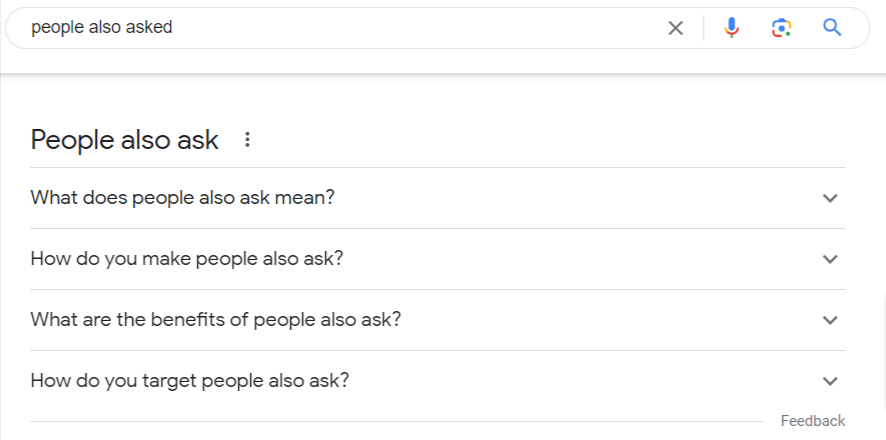Have you ever noticed those extra questions that pop up in SERPs when you look something in Google?
That’s “People Also Ask” (PAA) in action! It’s like having a helpful friend who anticipates what you might want to know next.
Let’s say you’re planning a trip and you search for “best travel destinations.”
Alongside your main search results, you’ll see more questions like “What are the safest countries to visit?” or “Where can I go on a budget?”
These extra questions can lead you to even more helpful information.
But PAA isn’t just handy for users—it’s a big deal for businesses too.
By understanding PAA, You can make sure your websites show up when people ask those extra questions. It’s like getting extra chances to be noticed online!
The Evolution of PAA: A Brief Overview
The PAA feature, introduced by Google in April 2015, has transformed into a critical facet of SEO and content strategies.
Data reveals a radical increase in the prevalence of PAA boxes, now appearing in approximately 40-42% of both desktop and mobile Search Engine Results Pages (SERPs).
The study presents a snapshot of the shifting dynamics in Google’s search features.

Key Findings!
“People Also Ask” boxes are present in almost half of all searches within the dataset, showcasing a remarkable growth trend.
The study highlights that Google utilizes PAA for query refinement, opening up opportunities for first-page visibility on previously broad search terms.
A PAA SEO strategy proves effective across various sectors, with industry-specific breakdowns guiding the allocation of optimization efforts.
Big brands have the chance to control answers in PAA boxes on branded search terms, but this also comes with potential risks.
Unlike featured snippets, it is possible to appear in a PAA box and hold a standard organic ranking on the first page of Google.
PAA results often appear within the top 3 results, providing a substantial chance of high visibility.
When a PAA result appears, it is within the top 3 results 75% of the time.
Text-based content is predominant in PAA results, with 48% of PAA boxes exclusively from text in paragraphs.
Untapped opportunities exist for video content within PAA boxes, where suitable text results are unavailable.
Understand the ‘People Also Ask’ Box!
As per my point of view understanding the mechanics of the “People Also Ask” box is crucial for effective optimization. The PAA box is an interactive feature displaying questions related to the original search query.
Clicking on a question reveals a snippet answer from a website, simultaneously prompting new questions to be added dynamically to the PAA box.
This is a wide process and high range of relevant FAQs list pop-down on every click.
PAA’s Role in Featured Snippets
The “People Also Asked” feature appears in search results as a set of related questions that users might find relevant to their initial query.
These questions are generated algorithmically based on user behavior and search patterns. When users click on one of these questions in the PAA section, it expands to reveal a brief answer, often taken directly from a web page that ranks well for the corresponding question.
Now, here’s where the connection with featured snippets comes into play. Featured snippets are concise, direct answers extracted from web pages that Google showcases at the top of search results.
Elevating Your Content with Featured Snippets:
Securing a spot in the “People Also Ask” feature can be advantageous for your content’s visibility, but the real SEO gold lies in featured snippets.
Featured snippets are prominent placements that can significantly increase your click-through rates and establish your content as an authoritative source.
Strategies to Secure a Featured Snippet:
You can craft your content to provide clear and concise answers to common user queries.
So, use structured content with well-defined headers and bullet points to make it easy for search engines to extract relevant information.
Use Descriptive Subheadings:
You need to break down your content into sections with descriptive subheadings. This not only enhances readability for users but also makes it easier for search engines to understand the structure and content of your page.
Optimize for Key Phrases:
You should Identify key phrases and questions that users are likely to ask. Incorporate these naturally into your content, especially in headers and subheadings.
Focus on User Intent:
You should understand the intent behind user queries and create content that addresses that intent comprehensively.
This increases the chances of your content being selected for featured snippets.
Leverage Schema Markup:
Implementing schema markup can provide additional context to search engines about the content on your page, potentially increasing the chances of being selected for featured snippets.
By strategically optimizing your content for both the “People Also Asked” feature and featured snippets, you can maximize your visibility in search results and position your website as a go-to source for user queries.
PAA vs. Featured Snippets: A Comparative Analysis!
The study draws a compelling comparison between “People Also Ask” and featured snippets, revealing that PAA results are six times more likely to appear within a SERP than featured snippet results.
This emphasizes the growing significance of PAA in Google’s strategy to deliver quick and concise answers directly on the search results page.
This is most likely because a significant portion of search queries in the search engines are based on frequently asked questions (FAQs).
Frequency of PAA Results Across Devices!
Data illustrates a consistent rise in the frequency of “People Also Ask” results on both mobile and desktop platforms.
PAA results appeared in approximately 49.37% of search results for desktop and 52.27% for mobile within the analyzed dataset.
This helps user to find most nearest queries if they are willing to explore them through these suggestions by Google.
Industry Variances in PAA Presence!
Analyzing “People Also Ask” presence across 25 industries uncovers variations from a minimum of 9.5% in Real Estate to a maximum of 64.2% in Computers & Electronics.
This sheds light on the differing intents of searches within various sectors, influencing the likelihood of PAA appearances.
Brand Protection and PAA!
The study delves into brand protection with “People Also Ask”, showcasing that most major brands trigger PAA regardless of their industry.
This emphasizes the need for brands to audit and secure ownership of PAA answers for both brand protection and competitive advantage.
Positioning of PAA Boxes in SERPs!
Over 58% of the time, the “People Also Ask” block appears after the first organic result, with more than 75% of PAA results featuring in the top 3 results of Google.
This positioning solidifies PAA as one of the most consistent and visible search features.
Can PAA Boxes Help You Rank Twice on Page 1?
Contrary to featured snippets, it is possible to have a presence inside a “People Also Ask” box and rank on the first page of results.
The study reveals that 13% of sites within the PAA box also hold a top 3 ranking.
This presents an intriguing opportunity for sites, particularly those with less authority, to gain visibility on the first page.
The Role of Query Length in PAA Appearance!
Now the real issue rise when you want to optimize your content to appear in “People Also Ask” section.
The study identifies a correlation between query length and PAA appearance. Longer keywords and more complex search queries are more likely to trigger PAA results.
As the number of words and specificity of the query increase, the occurrence of PAA boxes also rises.
Types of Queries Triggering PAA
“People Also Ask” boxes are commonly triggered by queries starting with question words such as:
- What
- Why
- When
- Where
- Who
Queries starting with these terms trigger PAA 86% of the time.
The study suggests structuring content around the intended question for optimal visibility. Which is also consider to include FAQs as the part of your content if it fulfills the intent of user.
Content Analysis within PAA Boxes
What types of content are found within “People Also Ask” boxes is crucial to understand for effective optimization.
The study reveals four types of blocks that can appear when clicking on a PAA question:
- Paragraphs: 79% of PAA boxes consist of paragraphs taken from website content.
- Lists: Lists comprise a smaller percentage of PAA results.
- Videos: Video content remains an untapped opportunity.
- Tables: Tables offer a format for displaying more data within PAA results.
Leveraging the ‘People Also Ask’ Feature
With the rise of PAA and increasing competition for SERP features, a viable action plan is essential.
Get an Overview of Existing SERP Features:
One essential aspect is getting familiar with the different features that appear on the search engine results page (SERP).
These features can include things like featured snippets, knowledge panels, and, of course, People Also Ask (PAA).
To gauge the presence of PAA for your target keywords, you can leverage various SEO tools. These tools can analyze search results and indicate whether PAA appears for specific queries.
By identifying which keywords trigger PAA features, you gain valuable insights into potential opportunities for optimization.
Competitor analysis is a cornerstone of effective SEO strategy.
By examining where your competitors rank in search results, you can gain valuable insights into the competitive landscape. Specifically regarding PAA, studying your competitors’ positions can reveal their optimization strategies and help you identify areas for improvement.
Find Missing PAA Opportunities:
While identifying existing “People Also Ask” features is essential, it’s equally crucial to uncover untapped opportunities where PAA could benefit your website.
Organic research involves analyzing the keywords for which your website already ranks in search engine results.
By using tools like SEMrush or Ahrefs, you can identify these keywords and determine whether they trigger PAA features. If you find keywords where your website ranks but PAA is not present, it indicates a potential opportunity to optimize for PAA.
Once you’ve identified keywords where PAA features are absent, the next step is to optimize your content to fill those gaps.
This optimization might involve crafting content that directly addresses the questions presented in PAA or restructuring existing content to better align with user queries.
Steal the Spotlight From Competitors:
To gain an edge over your competitors, it’s essential to identify keywords for which they rank highly but do not trigger SERP features like “People Also Ask”.
Utilize tools like SEMrush or SpyFu to conduct competitor analysis and identify these high-ranking keywords.
By pinpointing opportunities where your competitors are missing out on SERP features, you can formulate a strategy to capitalize on these gaps.
Once you’ve identified keywords where competitors are not leveraging SERP features like PAA, the next step is to optimize your content to secure these features for yourself.
You should craft content that directly addresses the questions posed in PAA and aligns with user intent.
By doing so, you increase the likelihood of your website being featured prominently in search results, stealing the spotlight from competitors and attracting more organic traffic.
Get Content Ideas to Win PAA SERP Features:
Several tools can provide valuable data on “People Also Ask” questions related to specific keywords.
Tools like SEMrush, Ahrefs, or AnswerThePublic can generate lists of PAA questions for any given keyword.
By exploring these tools, you can uncover the common questions users ask in your niche, allowing you to tailor your content accordingly.
In addition to gathering PAA data, utilize content ideation tools to brainstorm topics and phrases that are likely to trigger PAA features.
Tools like BuzzSumo or Google Trends can help identify trending topics and popular questions in your industry.
By leveraging these tools, you can generate content ideas that resonate with your audience and increase your chances of securing PAA features.
Check If Your Content Meets SEO Requirements:
When crafting content, prioritize addressing specific user queries that align with your target keywords.
By incorporating these queries into your content, you increase the likelihood of your website being featured in “People Also Ask” results.
To ensure your content meets SEO standards, leverage tools that provide suggestions for optimization.
Platforms like Yoast SEO or SEMrush offer insights into areas where your content can be improved for better search visibility.
These tools may suggest improvements in areas such as keyword usage, readability, and meta tags, helping you fine-tune your content for maximum SEO impact.
Define a Specific PAA Strategy:
You can start by analyzing your existing content and identifying opportunities to optimize for PAA.
Determine which topics or keywords align with PAA questions and prioritize creating content that directly addresses these queries.
You should craft comprehensive, well-structured answers that provide value to users and position your website as an authoritative source in your niche.
You can consider implementing structured data markup, such as FAQ schema, to enhance the likelihood of your content being featured in PAA. Structured data helps search engines understand the context and relevance of your content, increasing the chances of it being selected for PAA display.
Instead of solely focusing on traditional ranking factors, such as keyword density or backlinks, prioritize PAA tactics in your SEO strategy.
Monitor your performance within PAA features regularly and adjust your strategy as needed. Continuously analyze the questions being presented in PAA and refine your content to better address user intent and provide valuable insights.
Summary of the Topic
- The Evolution of PAA: A Brief Overview
- PAA has evolved to become a prominent feature in search results, providing users with a curated selection of related questions.
- Its evolution reflects the search engine’s commitment to enhancing user experience and providing more comprehensive search results.
- Understand the ‘People Also Ask’ Box!
- The PAA box is a dynamic feature that appears alongside search results, offering users a glimpse into commonly asked questions related to their query.
- Understanding how the PAA box operates and the mechanics behind its generation is essential for optimizing content effectively.
- PAA’s Role in Featured Snippets
- PAA often serves as a gateway to featured snippets, which are prime real estate in search results.
- Optimizing content to secure a spot in PAA increases the likelihood of being featured in a featured snippet, further elevating visibility and driving traffic.
- Leveraging the ‘People Also Ask’ Feature
- Businesses can leverage the PAA feature to enhance their visibility and authority in search results.
- Crafting content that directly addresses PAA questions and aligns with user intent is key to success in leveraging the PAA feature.
In summary, understanding the evolution of PAA, its role in featured snippets, and how to effectively leverage the PAA feature are essential components of a successful SEO strategy. By optimizing content to align with PAA queries and user intent, businesses can enhance their visibility, drive organic traffic, and establish themselves as authoritative sources in their respective niches.



